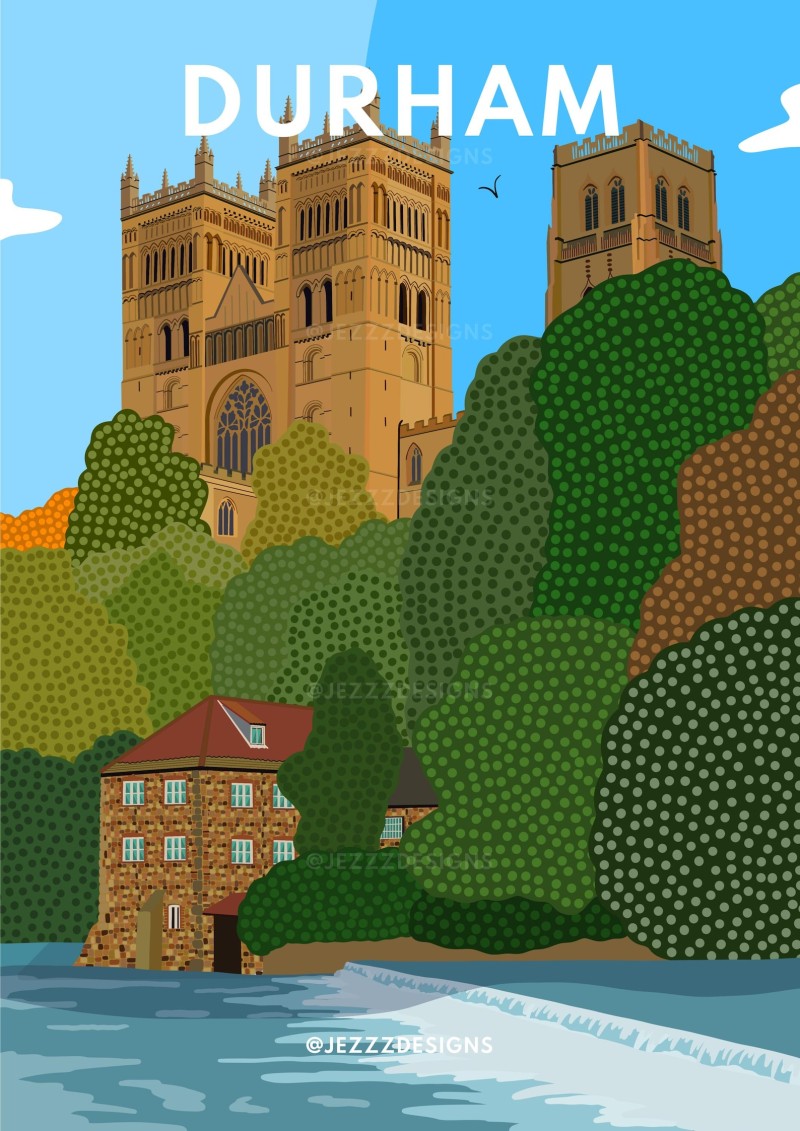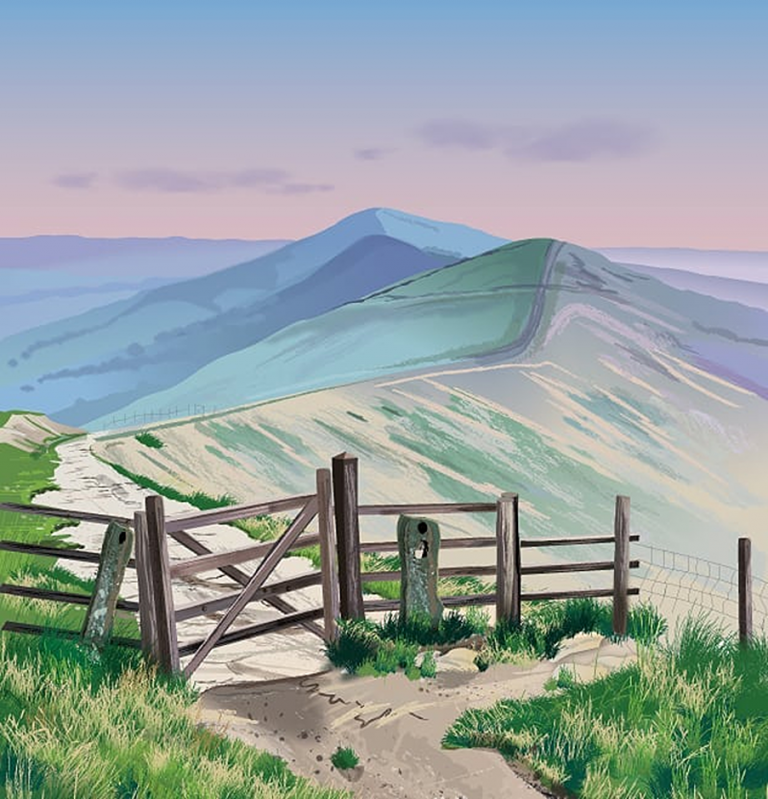
If you love places that mix old stories with lively energy, Durham is easy to fall for. This small city sits on the River Wear, rolling across seven hills, with the striking cathedral and university at its heart. Every corner seems to carry a bit of history and local charm, yet Durham doesn’t feel stuck in the past.
You’ll find famous landmarks, hidden nooks, and surprising facts scattered through its winding streets. Whether you’re keen on stunning views, old legends, or just want a taste of daily life here, Durham welcomes you. Let’s see what gives this corner of North East England its special spark.
If walking in nature, always follow the Countryside Code, to keep dogs and barnyard friends safe. If visiting the nearby coast, read our post on keeping dogs safe by the seaside.
A City Built on Seven Hills
Durham’s dramatic setting makes it unlike most English towns. Built across seven hills, the city rises and falls in a patchwork of steep streets, green banks, and stone buildings with the River Wear curving around the centre like a silver ribbon. The hills create more than a postcard view—they shape how the city looks, feels, and even how people move through it.
Geography That Shapes the City
Durham’s hills are not just a background. They cut through the centre and edge out to the suburbs, setting the stage for every walk and every glance. The city’s heart stands on rocky ground, surrounded by the River Wear which loops almost fully around it, leaving the medieval core on a natural peninsula. This feature once made Durham easy to defend, and now it gives the city a sense of closeness.
The river’s curving path means many of the main sights, from the grand cathedral to university colleges, stand high above the water. Houses, shops, and cobbled lanes tumble down towards the Wear or rise up steep banks, giving each street its own character and view.
The Seven Hills: Echoes of Ancient Cities
The idea of a city built on seven hills carries a certain weight. Rome might be the most famous example, but Durham’s seven hills are a source of pride and local stories. Each hill has its own name and shape, but together, they give Durham its unique skyline and feeling. People here sometimes list them out in conversation, almost like a badge of honour.
Here’s a look at the seven hills that make up front and centre in the city’s identity:
- Cathedral Hill (Palace Green): The spiritual centre, with the cathedral and castle towering above the river
- Windy Hill: Known for its sweeping outlooks across the city
- Mount Joy: A leafy rise, popular with students and walkers
- Whinney Hill: Edged by college buildings and family homes
- Claypath Hill: Where the old main road leads into town
- Gilesgate: Now a busy suburb, once a key entry into Durham
- Crossgate: Old streets lining the slopes across from the castle
While not as grand as Rome’s, Durham’s hills mean the city has few straight, flat streets. Instead, you find hidden lanes, steps, and bridges tucked into every slope. This gives the city its winding, often playful feeling and rewards those who like to explore on foot.
Famous Views and Vantage Points
The hills offer plenty of spots to pause and look out. Some of the most famous views in Durham are thanks to these rising slopes, each giving a snapshot of the city’s skyline or the river winding through the trees. Expect to see:
- The cathedral and castle gleaming above the Wear, especially from Prebends Bridge and below the college gardens
- The city centre tucked between the hills from Mount Joy or Observatory Hill
- The old rooftops and narrow streets from the high lanes around Palace Green
People say you haven’t really seen Durham until you’ve climbed at least one of its hills. The changing heights mean every walk feels different, with distant hills sometimes lost in the mist and then clear again by afternoon.
The River Wear’s Embrace
The River Wear is just as important as the hills. Flowing in a loop around the old city, it serves like a natural moat and walking path in one. From boaters rowing alongside College Green to dog walkers on the riverside paths, the river creates a sense of calm at the heart of the city.
This looping shape also makes Durham feel contained, almost like a village pressed close for warmth. As you move away from the centre, the city opens out, but always with green views down to the water below and the built-up slopes above. Many locals never tire of these riverside routes, which link parks, gardens, and secret viewpoints.
How Durham’s Shape Affects Life
Living in a city built on seven hills comes with quirks. Locals joke about needing strong legs, given the steep climbs between shops or from the station up to the centre. Students, especially, know all about racing up the banks to catch a lecture. Still, these slopes give the city its sense of freedom and surprise.
- Transport: Few straight roads, so walking and cycling mean lots of ups and downs
- Shops and Homes: Many places sit at odd angles or face unexpected ways, fitting the old slopes
- Events: Races, processions, and parades often zigzag up and down, turning streets into stages
The city’s mix of hills, rivers, and closeness gives Durham a feeling you won’t find elsewhere. Each visit seems to reveal a new path or park view, making it easy to see why people find this city so memorable.
History That Shaped Durham
Durham wears its history in plain sight, from the ancient stones of its cathedral to the stories passed along by families who have lived here for generations. The city’s past is full of turning points and characters that still feel present as you wander its streets.
Two moments stand out for how they shaped Durham’s spirit: the tale of St Cuthbert’s resting place, and the grit that carried its people through the toughest times.
St Cuthbert and the Legend of the Mist

St Cuthbert lived on Lindisfarne and the Farne Islands, but is buried here. He used to guard sheep and passed laws to protect eider ducks, regarded as ‘the world’s first environmentalist’. It’s said that after he went swimming, otters would dry his feet, with their fur!
It’s said that he became a monk after witnessing angels carrying St Aiden (the monastery’s abbot) to Heaven.
St Cuthbert’s journey belongs to the heart of Durham’s story. In the 9th century, as Viking raids swept England, monks carried the remains of St Cuthbert (one of the most loved saints in northern England) from place to place, always seeking safety from danger. Their path was long and winding, crossing rivers and hills, with the body moved again and again for fear of attack.
According to legend, the monks reached a wild, wooded hill—what is now Durham. Here, the story says, St Cuthbert’s coffin became too heavy to carry. The monks took this as a sign from above that they had reached the chosen resting spot. They settled, a small community grew, and eventually, the magnificent Durham Cathedral was built as a shrine to the saint.
What makes this legend so memorable?
- The idea that the land itself chose St Cuthbert’s resting place
- The stunning cathedral that now stands guard over his remains
- The sense of protection that still lingers in stories today
This feeling of protection only grew stronger during World War II. As bombs fell on cities across Britain, Durham seemed shielded by something unseen. Locals still talk about the “mist of St Cuthbert.” According to the story, a thick fog regularly rolled over the cathedral and the old city on nights when bombers flew overhead. Pilots reported not being able to find their target, saving the city from disaster.
Try to picture it: blacked-out streets, air raid sirens echoing, families huddled together—and then, the sudden lift of worry as the mist rolls in, hiding the soaring cathedral spire. Whether you believe the legend or not, that strong sense of being watched over is woven into Durham’s character even now.
Durham in Hard Times: The Great Depression
Durham’s streets are lined with old miners’ terraces, stone chapels, and school buildings. These speak of times when work was tough and money was tight, especially during the Great Depression of the 1930s.
When the coal industry slumped, wages shrank, and jobs disappeared almost overnight. Families lived close together in small houses, sharing what they had and making ends meet however they could.
Shops closed early, men queued at the colliery gates, and uncertainty became the norm. Yet, through those bleak days, communities in Durham refused to give up hope.
Neighbours pitched in for each other. If someone ran out of food or coal, a bit would be found next door. Local churches and clubs became lifelines, handing out cups of tea or running clubs for children whose parents were struggling. Simple comforts—a loaf of bread, a warm fire, a borrowed book—got families through.
Here’s what often brought people together during those years:
- Mutual aid: Sharing meals, looking after each other’s children, passing around spare clothes
- Strong unions: Workers came together to demand better pay and working conditions
- Public spaces: Parks, community halls, and even the riverbanks became places to gather, talk, and find support
Though the tough times lasted longer than anyone hoped, Durham’s spirit stayed strong. You can still feel the sense of sticking together in the city’s close-knit neighbourhoods and at local events today.
Many residents trace their roots to these years, and the pride in surviving hard times remains part of how the city describes itself. The story of the Great Depression isn’t just history, it’s a reminder of what communities can achieve when they care for each other.
Durham Cathedral and Castle
It’s hard to talk about Durham without picturing its cathedral and castle rising above the city, almost like guardians perched over the Wear. These two landmarks form a striking silhouette, especially on misty mornings or when the evening sun turns the sandstone golden.
They don’t just dominate the skyline either. They’ve shaped the city’s history, culture, and daily life for almost a thousand years.
The Cathedral: Grandeur on the Hill
Durham Cathedral isn’t just another old church. It calls out with bold architecture and an undeniable sense of purpose. Built between 1093 and 1133, its thick Norman pillars hold up soaring ribbed vaults, some of the earliest examples in Europe.
The stonework feels solid and weighty, but also somehow light as it lifts your eyes to the windows high above. Outside, the twin towers rise above treetops, while the central tower often disappears into the clouds.
Inside, the air always feels cool, carrying a silence that hushes even school groups and the busiest tourists. Light spills through stained glass windows and dances across centuries-old stone.
You can almost feel the footsteps of pilgrims who came here to visit the shrine of St Cuthbert, whose remains gave this place its purpose.
Today, the cathedral is still a working church, with daily services, music echoing through the nave, and the promise of peace for anyone who steps inside. Whether you visit for a quiet moment or one of the many concerts and events, the sense of history is almost physical.
The Castle: From Fortress to College
Just a stone’s throw from the cathedral sits Durham Castle, as much a part of city life as the bells which ring out each Sunday. First built in 1072, the castle has seen everything from royal feasts and sieges to lazy afternoons now, as part of Durham University.
This castle was not built for show. Its thick walls, narrow staircases, and high battlements were made to keep the city safe in the wild days when armies moved along the northern border. Later, it became the grand home of the Bishop of Durham, who ruled the region almost like a king.
When the university arrived in the 19th century, the castle developed a new role. These days, it houses students, who get to call this medieval fortress home, at least during term time.
Their World Heritage status means both sites are fiercely protected and carefully cared for. Conservation work happens year-round to guard against the slow wear and tear of wind, rain, and the footsteps of thousands of visitors. Local traditions, annual processions, and carol services keep the sites alive not just as museums but as living pieces of the city.
The University: Life and Pulse of the City
Durham University shapes almost every part of city life. With close to 20,000 students, it keeps the city young, curious, and full of different voices. Durham’s colleges line narrow lanes and leafy hills. Each has its own quirks, with formal dinners, quirky sports, and student-run events that fill the calendar.
You don’t have to go far to see how much the university brings to the city. Cafés brim with students swapping ideas over laptops, theatres put on student plays, and bookshops serve both locals and scholars. The energy is steady but never frantic.
Being a university city means Durham finds its rhythm in term dates: the place is busy during term and gets a bit quieter in the holidays. Parents, professors, and alumni mix with daily crowds, making the shops and parks busier than you might expect for a place this size.
A Controversial Prime Minister Studied Here
Although Tony Blair was born in Scotland, his family moved to Durham when he was five, and as an adult, he returned from Oxford University and living elsewhere, to represent a new constituency, which was to make him an MP and then prime minister.
At first lauded as someone fresh and positive, of course since then, much controversy has ensued, due to it later been found that there were not weapons of mass destruction, meaning the war with Iraq (not authorised by a United Nations Security Council resolution) violated the UN charter. He now advises governments with his own foundation.
Conclusion
Durham is a place where old stones and fresh voices come together. The city’s stories are built into its hills, rivers, and the welcome you get from locals who know the value of holding onto tradition while letting new life in. Durham’s blend of ancient beauty, lived-in history, and a genuine sense of community makes every visit feel like you’ve found something special.
If you’ve never been, it’s a perfect city to wander and discover. Bring your own stories and see how they fit with Durham’s. Already know Durham? Share your memories or tips below and help others see why this northern gem stands out.
Thank you for reading. Let’s keep the conversation going—what would you add about Durham’s spirit or secret corners?





